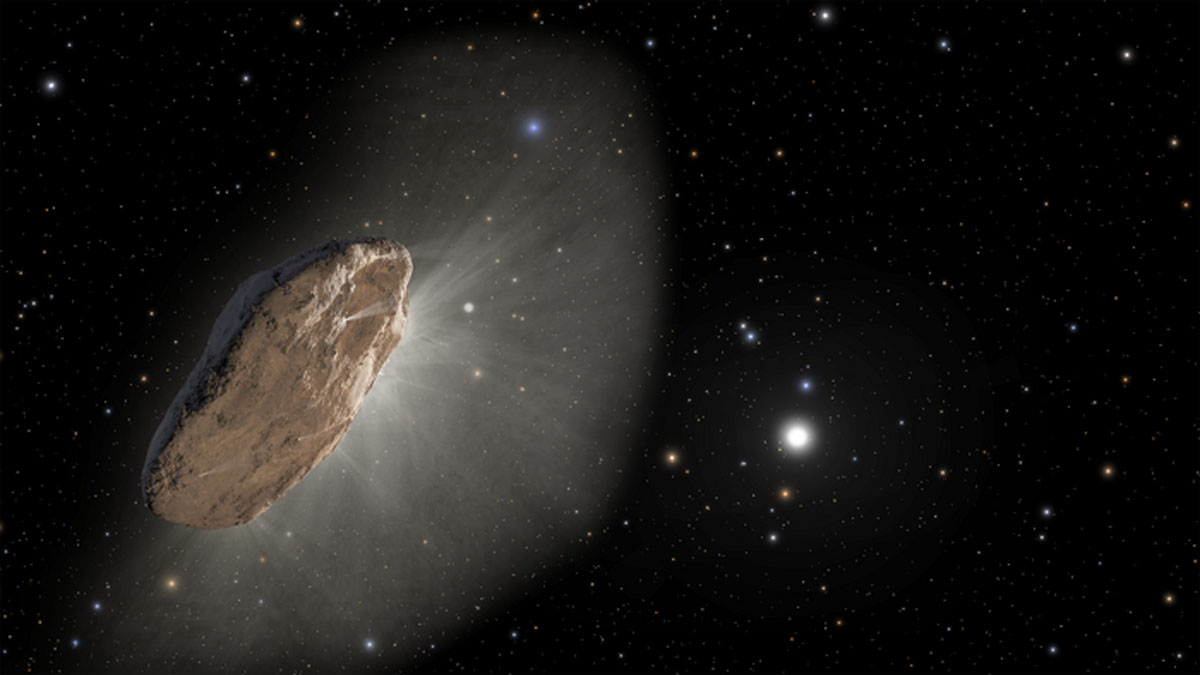
Since its surprise arrival in the solar system in 2017, the interstellar object 'Oumuamua has puzzled scientists. A duo of American astronomers now think they have solved one of the space rock's lingering mysteries.
First thought to be an asteroid, later recast as a likely comet, and by some even considered a possible alien spaceship, the 650-foot-long (200 meters) 'Oumuamua zoomed through the central solar system in late 2017. During its brief visit, the rock approached Earth within 15 million miles (24 million kilometers), about 62 Earth-moon distances, and disappeared a few weeks after its discovery.
Observations made within this short period of time soon proved that 'Oumuamua was on what astronomers call a "hyperbolic" orbit, a boomerang-shaped trajectory that indicated the rock is not native to our solar system but was only passing through the sun's neighborhood and would never be seen again.
Related: Interstellar object 'Oumuamua still puzzling scientists 5 years after discovery
The first interstellar body ever observed, 'Oumuamua was a sensation, prompting astronomers all over the world to bury themselves in the available data to learn all there was to learn about the object.
One of the questions that scientists struggled to answer had to do with Oumuamua's speed, which seemed to increase as the rock rounded the sun. Large bodies, such as planets and stars, can give smaller objects, including comets and asteroids, a gravitational kick that speeds them up. But in the case of 'Oumuamua, which at 54 miles per second (87 kilometers per second) cruised three times faster than an average solar system comet, these gravitational kicks couldn't explain the observed acceleration.
This acceleration swayed many scientists to conclude that, rather than an asteroid, 'Oumuamua must be a comet. Comets in the solar system receive additional momentum from the water and dust that evaporates from their icy nuclei as they warm up close to the sun. These comets, however, are famous for their spectacular tails that light up as a result of the outgassing process. And 'Oumumua showed no signs of a tail.
Many scientists have tried to explain the mechanism behind 'Oumuamua's acceleration, but all of the proposed ideas have had significant gaps. In a new study, Jennifer Bergner, an assistant professor of chemistry at the University of California, Berkeley and Darryl Seligman, a U.S. National Science Foundation postdoctoral fellow at Cornell University, propose a new theory, which they think might finally put the issue to rest.
"I have been trying to explain the outgassing for several years now," Seligman told Space.com. "First, I thought that perhaps there just wasn't too much dust in the outgassing [to form the coma]. Later, we thought that perhaps it was made of some more volatile material than what we see in usual comets, such as hydrogen, nitrogen or carbon monoxide. But there were theoretical issues with each of these explanations."
Hydrogen, for example, would require extremely cold temperatures to freeze into objects the size of 'Oumuamua, and scientists don't expect such temperatures inside the dense molecular clouds where these objects form, Seligman said. Nitrogen is not ubiquitous enough in the Milky Way to account for the expected number of such bodies in the galaxy, he added.
Seligman and Bergner now propose that there might be nothing extraordinary about 'Oumuamua's chemistry. Instead, the object was subject to processes outside the solar system that astronomers don't know about from our observations of domestic comets.
"A comet traveling through the interstellar medium basically is getting cooked by cosmic radiation, forming hydrogen as a result," Bergner said in a statement. "Our thought was: If this was happening, could you actually trap it in the body, so that when it entered the solar system and it was warmed up, it would outgas that hydrogen?"
Related: 'Oumuamua: The solar system's 1st interstellar visitor explained in photos
The team's calculations showed that, theoretically, the force of this outgassing hydrogen could explain the strange acceleration of 'Oumuamua. The astronomers even found experimental studies more than 40 years old that demonstrated that high-energy particles, such as those present in cosmic rays, can split molecular hydrogen from water ice but keep it trapped inside an ice block.
"What's beautiful about Jenny's idea is that it's exactly what should happen to interstellar comets," Seligman said in a statement. "We had all these stupid ideas, like hydrogen icebergs and other crazy things, and it's just the most generic explanation."
Although 'Oumuamua is gone forever, Seligman hopes that new interstellar visitors will be discovered soon that will help astronomers find any remaining answers, and also provide a window into other star systems in our Milky Way galaxy. New telescopes that are expected to supercharge this research are expected to come online within the next decade.
The new study was published online in the journal Nature on Wednesday (March 22).
Follow Tereza Pultarova on Twitter @TerezaPultarova. Follow us on Twitter @Spacedotcom and on Facebook.







